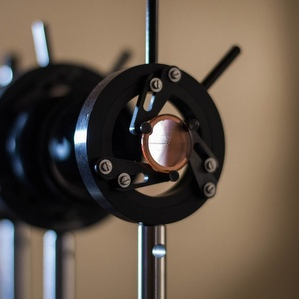Scientists of the Samara National Research University named after academician S.P. Korolev are developing a special educational constructor set for Russian schoolchildren to study and independently assemble an ultralight optical system for space satellites. Such systems, characterized by very compact dimensions and ultra-low weight, are expected to be installed in the near future on nanosatellites of remote probing of the Earth.
The development of an educational constructor set is carried out within the framework of the grant received by scientists from the Innovation Promotion Fund with the support of the government and the Samara Region Ministry of Economic Development and Investment. The optical system is based on a flat diffraction lens created at Samara University, which replaces the system of lenses and mirrors of modern telephoto lenses. In the manufacture of such a lens, a "resist" is applied to the surface of the quartz glass — that is a photosensitive substance with a thickness of 10 micrometers (for comparison, the thickness of a human hair is 40-90 micrometers).
A laser beam creates a 256-level relief on the resist. With its help, an "approximation" of the object occurs, and distortion compensation is provided by computer processing of the received images. An optical system based on such a lens is distinguished by its very low weight — about a few grams — and miniature dimensions comparable to the dimensions of a camera in a regular telephone.
"This will be a constructor set consisting of ready-made elements of the system. It will include lenses created on the basis of diffraction lenses, various sensors, cameras to which these lenses can be attached," said Sergei Bibikov, associate professor of Supercomputers and general computer science Department at Samara University. There will also be educational materials, special software and the ability to process the received images on our servers so as not to depend on weak computers at some school. This particular complex will give children opportunity to assemble the system that can be installed on nanosatellites."
According to Bibikov, this training kit can be used in the group work at schools and universities. "In the process of assembling this system, you can conduct various training sessions with schoolchildren, explain to them how this optics was created, what the features of its application are, how the image is processed on a computer. Using this constructor set you can combine a huge amount of educational content, so that various works and experiments can be carried out on its basis later. It can be useful in universities as the basis for various training courses," — said Bibikov.
The prototype will be prepared by March 2020. It should first be tested by schoolchildren participating in the "Duty on the Planet" program (this program combines space technology competitions and projects for schoolchildren and students and is implemented with the support of "Roscosmos" State Corporation as part of the "Interest groups Movement" roadmap of the National Technological Initiative).
Based on the results of testing, the constructor set will be improved and finalized, after that it will be possible to begin preparing pre-production samples. As the developers emphasize, that despite the educational nature of the set, it will be possible to assemble from its components the real optical system of a space satellite.
"We are developing this construction set so that it can be assembled into a real system that can be installed on a satellite and launched into the orbit," Bibikov said.
An optical system based on a diffraction lens will be ready for deployment on a nanosatellite and launch into space at the end of 2020 — the beginning of 2021. It is expected that the first samples of such optical systems will have a resolution of dozens of meters from an orbit of 400 km, which is certainly lower than the resolution of specialized optics installed on large remote sensing and probing devices.
However, on the basis of low-budget nanosatellites with compact optics it will be possible to create large-scale orbital constellations of hundreds of such spacecrafts, which will allow monitoring the Earth in almost real time, quickly obtaining an image of the required area of the Earth surface without waiting for the time when some large remote sensing device will appear over the right place. The information received will be very important for operational tracking, for example, the situation with the spread of natural fires, floods, for monitoring agricultural crops and for other purposes.
For reference:
Samara University is one of the world leaders in the field of research of diffractive optical elements and image processing. The diffraction lens developed at the University is one of the results of the 40-year work of the School of Information Optics and Photonics under the guidance of Academician of the Russian Academy of Sciences, Samara University President Viktor Soifer. The first article by Samara University scientists, confirming the possibility of using diffraction optics in imaging systems, appeared in May 2015 following the results of the largest world conference on image processing — IEEE Computer Vision and Pattern Recognition.
In November 2015, a joint work on a similar development was published by the University of Toronto and University named after King Abdullah in Saudi Arabia, with reference to the Samara University work. No one in the world has used diffraction optics to obtain high-resolution color images before.
Photo by Anastasia Korotkova
